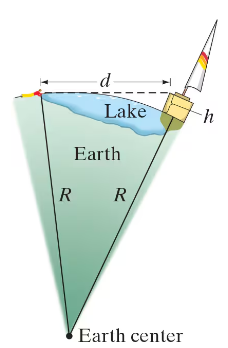 Back
BackProblem 57a
Show that the following combination of the three fundamental constants of nature that we used in Example 1–10 (that is G, c, and h) forms a quantity with the dimensions of time: tₚ = /c⁵. This quantity, tₚ, is called the Planck time and is thought to be the earliest time, after the creation of the Universe, at which the currently known laws of physics can be applied.
Problem 1e
How many significant figures does the following number have? 0.0086
Problem 1g
How many significant figures does the following number have? 8700
Problem 6.80b
A plumb bob (a mass m hanging on a string) is deflected from the vertical by an angle θ due to a massive mountain nearby (Fig. 6–37).
(b) Make a rough estimate of the mass of Mt. Everest, assuming it has the shape of a cone 4000 m high and base of diameter 4000 m. Assume its mass per unit volume is 3000kg per m³.
<IMAGE>
Problem 30
American football uses a field that is 100.0 yd long, whereas a soccer field is 100.0 m long. Which field is longer, and by how much (give yards, meters, and percent)?
Problem 52
Many sailboats are docked at a marina 4.4 km away on the opposite side of a lake. You stare at one of the sailboats because, when you are lying flat at the water's edge, you can just see its deck but none of the side of the sailboat. You then go to that sailboat on the other side of the lake and measure that the deck is 1.5 m above the level of the water. Using Fig. 1–14, where h = 1.5 m , estimate the radius R of the Earth.
Problem 55b
The speed v of an object is given by the equation v = At³ ― Bt, where t refers to time. What are the SI units for the constants A and B?
Problem 59
One mole of atoms consists of 6.02 x 10²³ individual atoms. If a mole of atoms were spread uniformly over the Earth's surface, how many atoms would there be per square meter?
Problem 77
The following formula estimates an average person's lung capacity V (in liters, where 1 L = 10³ cm³): V = 4.1H ― 0.018A ―2.7, where H and A are the person's height (in meters) and age (in years), respectively. In this formula, what are the units of the numbers 4.1, 0.018, and 2.7?
Problem 96b
Waves on the surface of the ocean do not depend significantly on the properties of water such as density or surface tension. The primary 'return force' for water piled up in the wave crests is due to the gravitational attraction of the Earth. Thus the speed v (m/s) of ocean waves depends on the acceleration due to gravity g. It is reasonable to expect that υ might also depend on water depth h and the wave's wavelength λ. Assume the wave speed is given by the functional form v = Cgᵅ hᵝ λᵞ, where α, β, , and C are numbers without dimension. In shallow water, the speed of surface waves is found experimentally to be independent of the wavelength (i.e., γ = 0 in our assumed equation above for v). Using only dimensional analysis, determine the formula for the speed of waves in shallow water.

